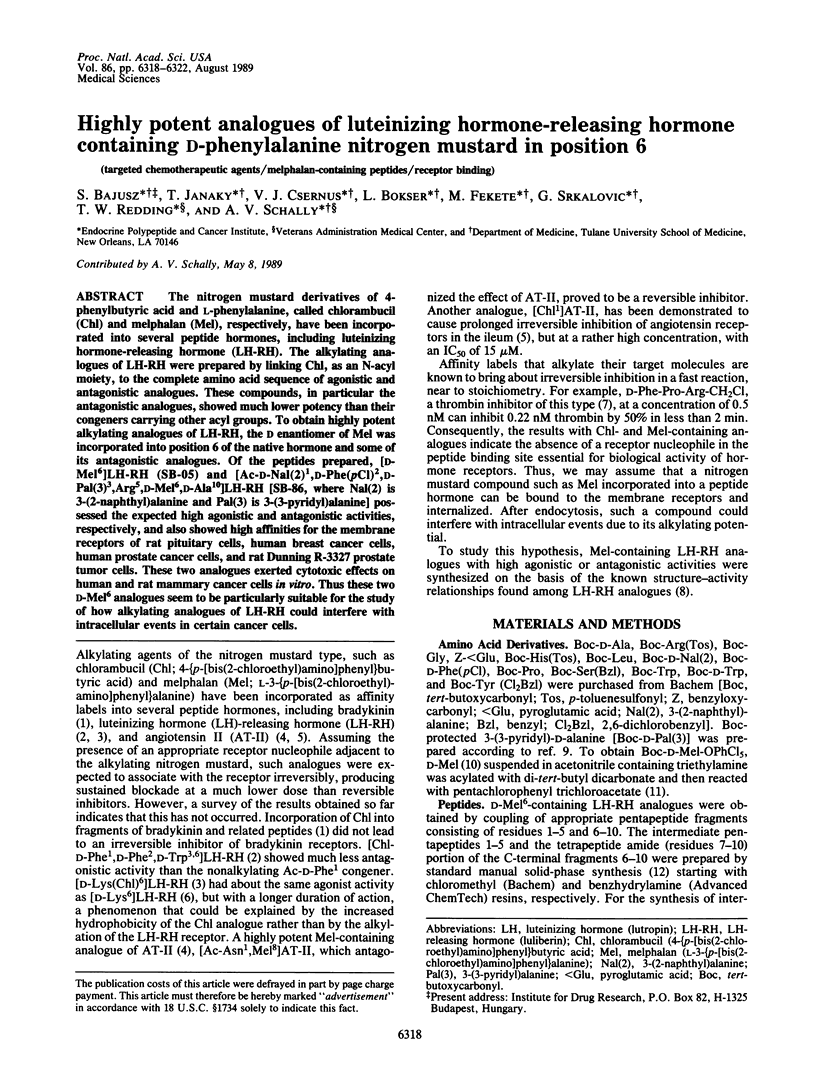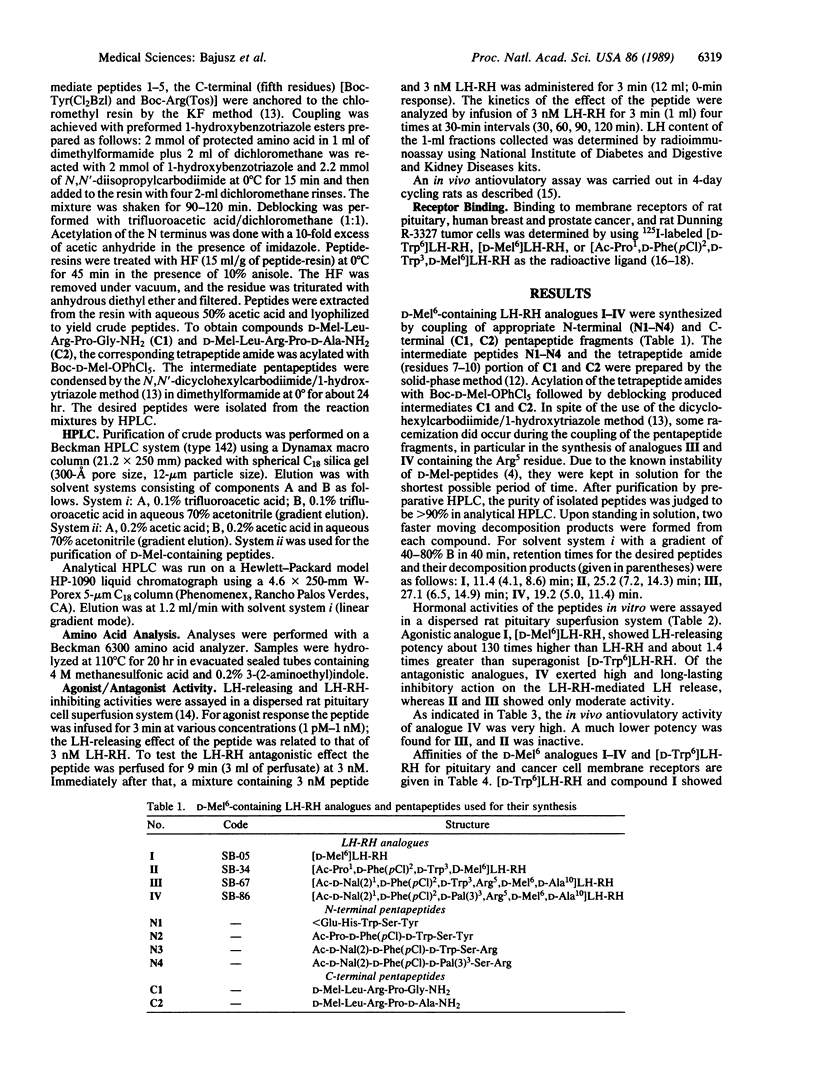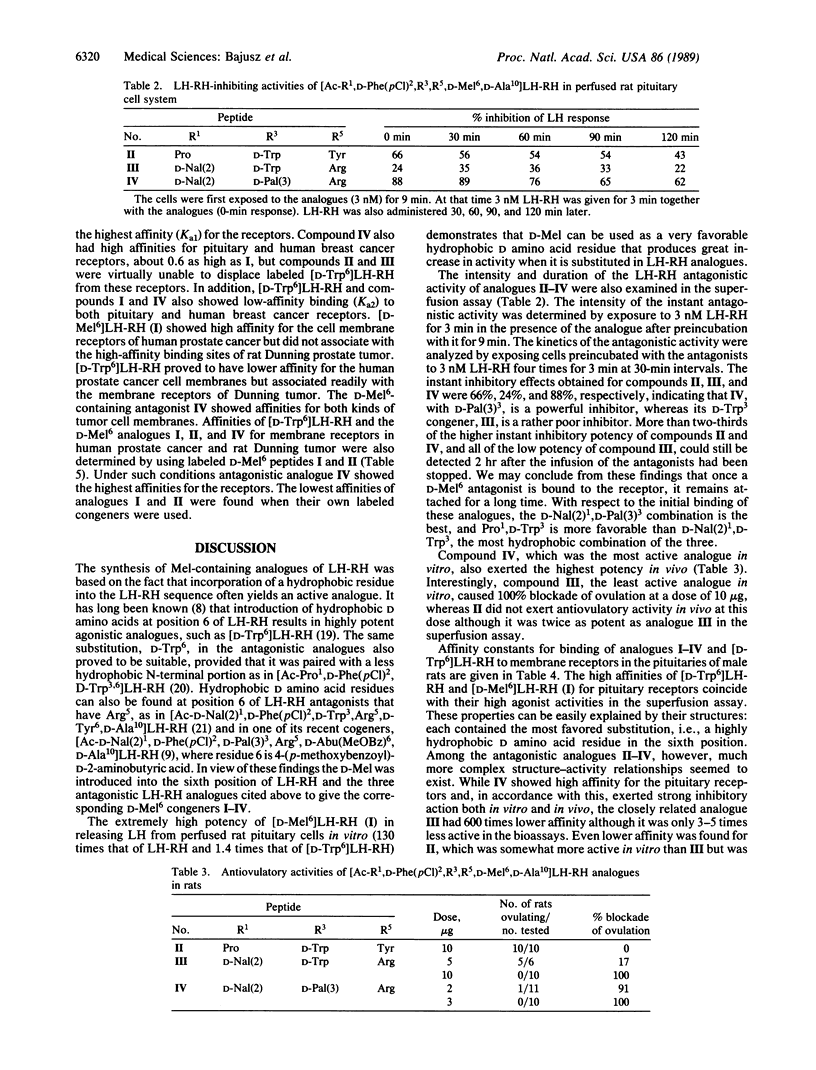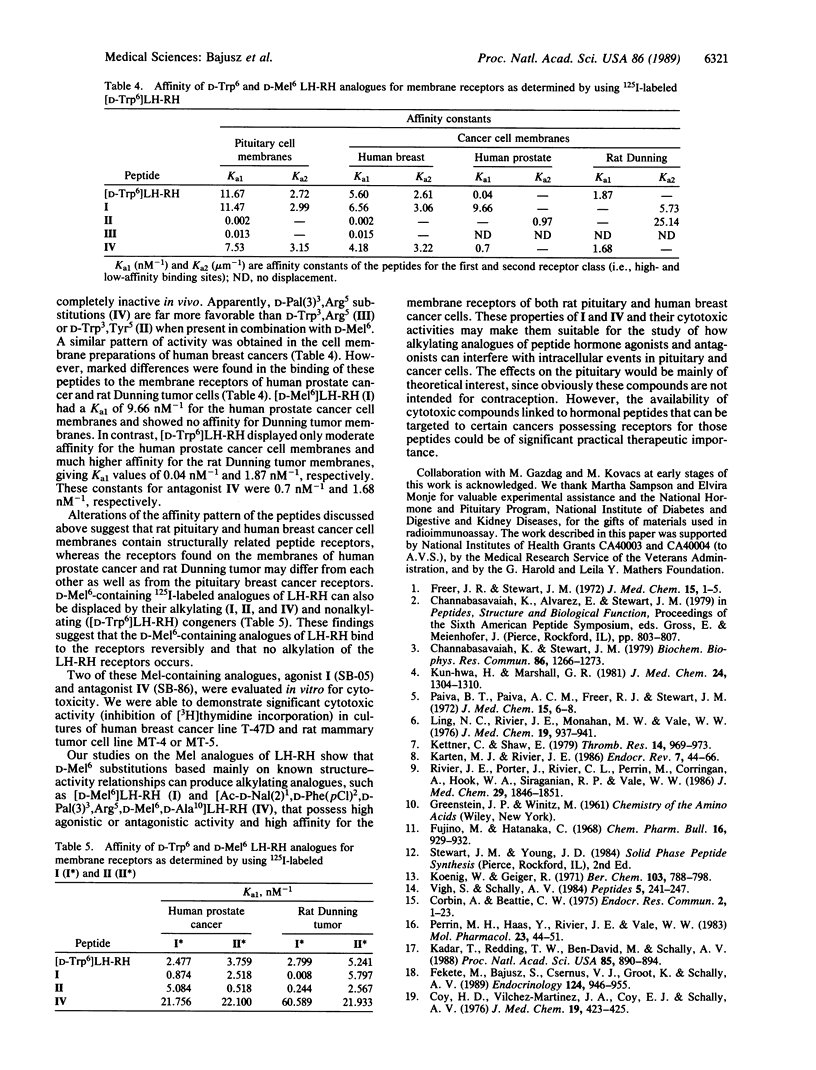Abstract
The nitrogen mustard derivatives of 4-phenylbutyric acid and L-phenylalanine, called chlorambucil (Chl) and melphalan (Mel), respectively, have been incorporated into several peptide hormones, including luteinizing hormone-releasing hormone (LH-RH). The alkylating analogues of LH-RH were prepared by linking Chl, as an N-acyl moiety, to the complete amino acid sequence of agonistic and antagonistic analogues. These compounds, in particular the antagonistic analogues, showed much lower potency than their congeners carrying other acyl groups. To obtain highly potent alkylating analogues of LH-RH, the D enantiomer of Mel was incorporated into position 6 of the native hormone and some of its antagonistic analogues. Of the peptides prepared, [D-Mel6]LH-RH (SB-05) and [Ac-D-Nal(2)1,D-Phe(pCl)2,D-Pal(3)3,Arg5,D-Mel6,D-Ala10++ +]LH-RH [SB-86, where Nal(2) is 3-(2-naphthyl)alanine and Pal(3) is 3-(3-pyridyl)alanine] possessed the expected high agonistic and antagonistic activities, respectively, and also showed high affinities for the membrane receptors of rat pituitary cells, human breast cancer cells, human prostate cancer cells, and rat Dunning R-3327 prostate tumor cells. These two analogues exerted cytotoxic effects on human and rat mammary cancer cells in vitro. Thus these two D-Mel6 analogues seem to be particularly suitable for the study of how alkylating analogues of LH-RH could interfere with intracellular events in certain cancer cells.
Full text
PDF




Selected References
These references are in PubMed. This may not be the complete list of references from this article.
- Channabasavaiah K., Stewart J. M. New analogs of luliberin which inhibit ovulation in the rat. Biochem Biophys Res Commun. 1979 Feb 28;86(4):1266–1273. doi: 10.1016/0006-291x(79)90253-5. [DOI] [PubMed] [Google Scholar]
- Corbin A., Beattie C. W. Ihibition of the pre-ovulatory proestrous gonadotropin surge, ovulation and pregnancy with a peptide analogue of luteinizing hormone releasing hormone. Endocr Res Commun. 1975;2(1):1–23. doi: 10.3109/07435807509053836. [DOI] [PubMed] [Google Scholar]
- Coy D. H., Vilchez-Martinez J. A., Coy E. J., Schally A. V. Analogs of luteinizing hormone-releasing hormone with increased biological activity produced by D-amino acid substitutions in position 6. J Med Chem. 1976 Mar;19(3):423–425. doi: 10.1021/jm00225a018. [DOI] [PubMed] [Google Scholar]
- Fekete M., Bajusz S., Groot K., Csernus V. J., Schally A. V. Comparison of different agonists and antagonists of luteinizing hormone-releasing hormone for receptor-binding ability to rat pituitary and human breast cancer membranes. Endocrinology. 1989 Feb;124(2):946–955. doi: 10.1210/endo-124-2-946. [DOI] [PubMed] [Google Scholar]
- Freer R. J., Stewart J. M. Alkylating analogs of peptide hormones. 1. Synthesis and properties of p-(N,N-)-bis(2-chloroethyl)amino)phenylbutyryl derivatives of bradykinin and bradykinin potentiating factor. J Med Chem. 1972 Jan;15(1):1–5. doi: 10.1021/jm00271a001. [DOI] [PubMed] [Google Scholar]
- Fujino M., Hatanaka C. A new procedure for the pentachlorophenylation of N-protected amino acids. Chem Pharm Bull (Tokyo) 1968 May;16(5):929–932. doi: 10.1248/cpb.16.929. [DOI] [PubMed] [Google Scholar]
- Hsieh K., Marshall G. R. Alkylating angiotensin II analogues: synthesis, analysis, and biological activity of angiotensin II analogues containing the nitrogen mustard melphalan in position 8. J Med Chem. 1981 Nov;24(11):1304–1310. doi: 10.1021/jm00143a009. [DOI] [PubMed] [Google Scholar]
- Kadar T., Redding T. W., Ben-David M., Schally A. V. Receptors for prolactin, somatostatin, and luteinizing hormone-releasing hormone in experimental prostate cancer after treatment with analogs of luteinizing hormone-releasing hormone and somatostatin. Proc Natl Acad Sci U S A. 1988 Feb;85(3):890–894. doi: 10.1073/pnas.85.3.890. [DOI] [PMC free article] [PubMed] [Google Scholar]
- Karten M. J., Rivier J. E. Gonadotropin-releasing hormone analog design. Structure-function studies toward the development of agonists and antagonists: rationale and perspective. Endocr Rev. 1986 Feb;7(1):44–66. doi: 10.1210/edrv-7-1-44. [DOI] [PubMed] [Google Scholar]
- Kettner C., Shaw E. D-Phe-Pro-ArgCH2C1-A selective affinity label for thrombin. Thromb Res. 1979;14(6):969–973. doi: 10.1016/0049-3848(79)90014-8. [DOI] [PubMed] [Google Scholar]
- König W., Geiger R. Eine neue Methode zur Synthese von Peptiden: Aktivierung der Carboxylgruppe mit Dicyclohexycarbodiimid unter Zusatz von 1-Hydroxy-benzotriazolen. Chem Ber. 1970;103(3):788–798. doi: 10.1002/cber.19701030319. [DOI] [PubMed] [Google Scholar]
- Ling N. C., Rivier J. E., Monahan M. W., Vale W. W. Analogues of luteinizing hormone releasing factor modified at positions 2, 6, and 10. J Med Chem. 1976 Jul;19(7):937–941. doi: 10.1021/jm00229a016. [DOI] [PubMed] [Google Scholar]
- Paiva T. B., Paiva A. C., Freer R. J., Stewart J. M. Alkylating analogs of peptide hormones. 2. Synthesis and properties of p-(N,N-bis(2-chloroethyl)amino)phenylbutyryl derivatives of angiotensin II. J Med Chem. 1972 Jan;15(1):6–8. doi: 10.1021/jm00271a002. [DOI] [PubMed] [Google Scholar]
- Perrin M. H., Haas Y., Rivier J. E., Vale W. W. Gonadotropin-releasing hormone binding to rat anterior pituitary membrane homogenates. Comparison of antagonists and agonists using radiolabeled antagonist and agonist. Mol Pharmacol. 1983 Jan;23(1):44–51. [PubMed] [Google Scholar]
- Rivier J. E., Porter J., Rivier C. L., Perrin M., Corrigan A., Hook W. A., Siraganian R. P., Vale W. W. New effective gonadotropin releasing hormone antagonists with minimal potency for histamine release in vitro. J Med Chem. 1986 Oct;29(10):1846–1851. doi: 10.1021/jm00160a008. [DOI] [PubMed] [Google Scholar]
- Vigh S., Schally A. V. Interaction between hypothalamic peptides in a superfused pituitary cell system. Peptides. 1984;5 (Suppl 1):241–247. doi: 10.1016/0196-9781(84)90282-1. [DOI] [PubMed] [Google Scholar]


